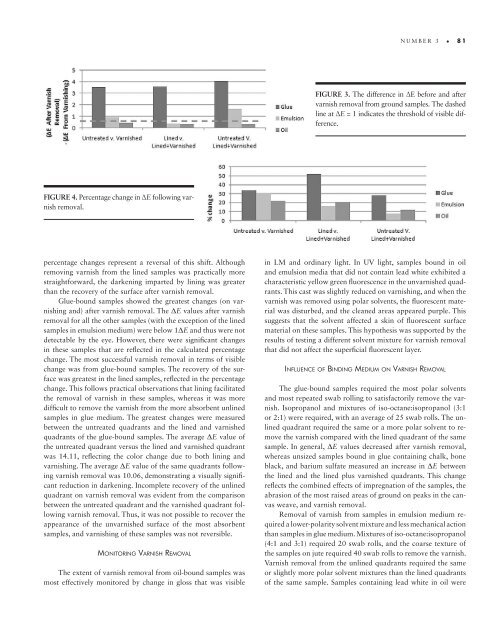Create successful ePaper yourself
Turn your PDF publications into a flip-book with our unique Google optimized e-Paper software.
number 3 • 81<br />
FIGURE 3. The difference in ∆E before and after<br />
varnish removal from ground samples. The dashed<br />
line at ∆E = 1 indicates <strong>the</strong> threshold <strong>of</strong> visible difference.<br />
FIGURE 4. Percentage change in ∆E following varnish<br />
removal.<br />
percentage changes represent a reversal <strong>of</strong> this shift. Although<br />
removing varnish from <strong>the</strong> lined samples was practically more<br />
straightforward, <strong>the</strong> darkening imparted by lining was greater<br />
than <strong>the</strong> recovery <strong>of</strong> <strong>the</strong> surface after varnish removal.<br />
Glue- bound samples showed <strong>the</strong> greatest changes (on varnishing<br />
and) after varnish removal. The DE values after varnish<br />
removal for all <strong>the</strong> o<strong>the</strong>r samples (with <strong>the</strong> exception <strong>of</strong> <strong>the</strong> lined<br />
samples in emulsion medium) were below 1DE and thus were not<br />
detectable by <strong>the</strong> eye. However, <strong>the</strong>re were significant changes<br />
in <strong>the</strong>se samples that are reflected in <strong>the</strong> calculated percentage<br />
change. The most successful varnish removal in terms <strong>of</strong> visible<br />
change was from glue- bound samples. The recovery <strong>of</strong> <strong>the</strong> surface<br />
was greatest in <strong>the</strong> lined samples, reflected in <strong>the</strong> percentage<br />
change. This follows practical observations that lining facilitated<br />
<strong>the</strong> removal <strong>of</strong> varnish in <strong>the</strong>se samples, whereas it was more<br />
difficult to remove <strong>the</strong> varnish from <strong>the</strong> more absorbent unlined<br />
samples in glue medium. The greatest changes were measured<br />
between <strong>the</strong> untreated quadrants and <strong>the</strong> lined and varnished<br />
quadrants <strong>of</strong> <strong>the</strong> glue- bound samples. The average DE value <strong>of</strong><br />
<strong>the</strong> untreated quadrant versus <strong>the</strong> lined and varnished quadrant<br />
was 14.11, reflecting <strong>the</strong> color change due to both lining and<br />
varnishing. The average DE value <strong>of</strong> <strong>the</strong> same quadrants following<br />
varnish removal was 10.06, demonstrating a visually significant<br />
reduction in darkening. Incomplete recovery <strong>of</strong> <strong>the</strong> unlined<br />
quadrant on varnish removal was evident from <strong>the</strong> comparison<br />
between <strong>the</strong> untreated quadrant and <strong>the</strong> varnished quadrant following<br />
varnish removal. Thus, it was not possible to recover <strong>the</strong><br />
appearance <strong>of</strong> <strong>the</strong> unvarnished surface <strong>of</strong> <strong>the</strong> most absorbent<br />
samples, and varnishing <strong>of</strong> <strong>the</strong>se samples was not reversible.<br />
Monitoring Varnish Removal<br />
The extent <strong>of</strong> varnish removal from oil- bound samples was<br />
most effectively monitored by change in gloss that was visible<br />
in LM and ordinary light. In UV light, samples bound in oil<br />
and emulsion media that did not contain lead white exhibited a<br />
characteristic yellow green fluorescence in <strong>the</strong> unvarnished quadrants.<br />
This cast was slightly reduced on varnishing, and when <strong>the</strong><br />
varnish was removed using polar solvents, <strong>the</strong> fluorescent material<br />
was disturbed, and <strong>the</strong> cleaned areas appeared purple. This<br />
suggests that <strong>the</strong> solvent affected a skin <strong>of</strong> fluorescent surface<br />
material on <strong>the</strong>se samples. This hypo<strong>the</strong>sis was supported by <strong>the</strong><br />
results <strong>of</strong> testing a different solvent mixture for varnish removal<br />
that did not affect <strong>the</strong> superficial fluorescent layer.<br />
Influence <strong>of</strong> Binding Medium on Varnish Removal<br />
The glue- bound samples required <strong>the</strong> most polar solvents<br />
and most repeated swab rolling to satisfactorily remove <strong>the</strong> varnish.<br />
Isopropanol and mixtures <strong>of</strong> iso- octane:isopropanol (3:1<br />
or 2:1) were required, with an average <strong>of</strong> 25 swab rolls. The unlined<br />
quadrant required <strong>the</strong> same or a more polar solvent to remove<br />
<strong>the</strong> varnish compared with <strong>the</strong> lined quadrant <strong>of</strong> <strong>the</strong> same<br />
sample. In general, DE values decreased after varnish removal,<br />
whereas unsized samples bound in glue containing chalk, bone<br />
black, and barium sulfate measured an increase in DE between<br />
<strong>the</strong> lined and <strong>the</strong> lined plus varnished quadrants. This change<br />
reflects <strong>the</strong> combined effects <strong>of</strong> impregnation <strong>of</strong> <strong>the</strong> samples, <strong>the</strong><br />
abrasion <strong>of</strong> <strong>the</strong> most raised areas <strong>of</strong> ground on peaks in <strong>the</strong> canvas<br />
weave, and varnish removal.<br />
Removal <strong>of</strong> varnish from samples in emulsion medium required<br />
a lower- polarity solvent mixture and less mechanical action<br />
than samples in glue medium. Mixtures <strong>of</strong> iso- octane:isopropanol<br />
(4:1 and 3:1) required 20 swab rolls, and <strong>the</strong> coarse texture <strong>of</strong><br />
<strong>the</strong> samples on jute required 40 swab rolls to remove <strong>the</strong> varnish.<br />
Varnish removal from <strong>the</strong> unlined quadrants required <strong>the</strong> same<br />
or slightly more polar solvent mixtures than <strong>the</strong> lined quadrants<br />
<strong>of</strong> <strong>the</strong> same sample. Samples containing lead white in oil were
















